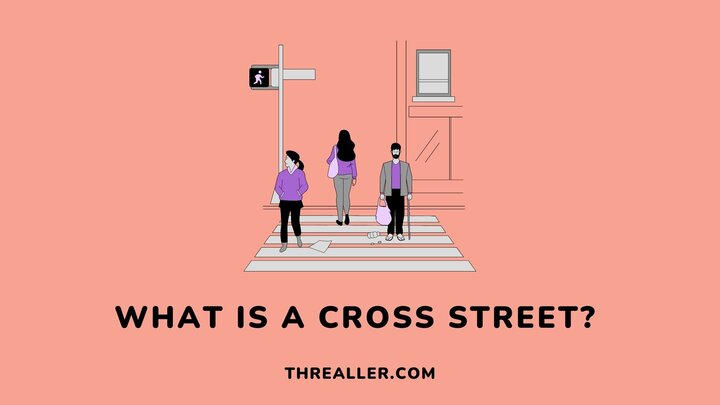The term “cross street” pops up when giving directions or describing a location. But what exactly does it mean? A cross street is simply a street intersecting or crossing another perpendicularly.
It can also be called an intersecting street, a side street, or a secondary street. In the U.S., cross streets are a feature of urban areas with a grid plan. They are usually the smaller streets that intersect major roads.
Here is a detailed guide that explains the meaning of a cross street, its significance, and how to locate them manually or automatically (via software).
Meaning of Cross Street
A cross street is a street that intersects or crosses another street at a right angle, forming a cross shape. These intersections are usually accompanied by stop signs or traffic lights, which allow vehicles and pedestrians to cross one another safely.
In most cases, this street runs perpendicular to the main street and could be on both sides. An example is the 42nd Street and Times Square intersection in New York.
Like other cross streets, this area is surrounded by essential and fascinating structures like theaters, restaurants, and parks, to name a few.
So, if you are a tourist or new to an environment, spotting the nearest cross streets can help you access basic amenities or attractions.
Types of Cross Street

There are two types of cross streets — controlled and uncontrolled.
1. Controlled cross streets
When a cross street is “controlled,” one road has priority over the other. These controls include road markings such as give way or stop lines, yellow boxes, and traffic lights.
These features are common in congested roads and indicate who has priority.
2. Uncontrolled cross streets
Uncontrolled cross streets mean no road has priority. They do not feature road markings or traffic lights.
Some cross streets are permanently uncontrolled. This is common in less congested or rural areas and should be carefully navigated.
Significance of Cross Streets
Helps with city planning and location description
Cross streets are a major building block for city planning and design. Since most cities employ a grid-system layout, cross streets also help with identifying locations, and buildings, and giving directions.
For example, specific street names such as “Avenues” or “Boulevard” can help signify what the street is all about or what to expect.
A measure of community growth or development
One way to understand a particular neighborhood’s characteristics and development is via intersecting streets. This is because locations with more cross streets enjoy more commercial activities and development than those with few.
Attracts tourists
Buildings and attraction sites such as parks and cinemas within a city are strategically situated in easily accessible spots and congested areas like cross streets.
Numerous cross streets within a city mean there are a lot of fascinating sites and structures to look forward to. This alone attracts tourists.
How to Locate a Cross Street
If you are new to an area, locating a cross street can be challenging. Here are a few hacks that can help:
- Look for landmarks such as buildings, parks, and other easily recognizable features. For example, a restaurant is usually located near a cross street to a particular park.
- You can also identify a cross street via street signs. However, this method requires understanding street signs.
- Using maps or atlases is another way to locate cross streets. Fortunately, smartphones now feature GPS applications such as Google Maps, making locating and navigating cross or side streets easy.
How to Find Cross Street on Google Maps and iOS Maps
Aside from viewing road maps or locations on your smartphone and identifying cross streets, there is a quick fix. Since a cross street is usually a perpendicular intersection between two roads, type “Street A & Street B” in the search space on Google or iOS Maps.
For example, if you type “Broadway & E 14th St, New York, NY” on Google Maps, it should display the intersection between both roads.
FAQs
Is a cross street the same as an intersection?
An intersection is where two or more roads meet or cross and can be in any direction. On the other hand, a cross street is where two streets intersect perpendicularly.
What is the difference between a cross street and an avenue?
A cross street runs perpendicular to the main street, while an avenue runs parallel.
What is the difference between a crossroad and a junction?
A crossroad involves the interaction of two roads while a junction is where two or more roads meet. This means a crossroad can be a junction but not all junctions are crossroads.
Summary
Cross streets are perpendicular intersecting streets. They are an integral part of urban planning and development. Areas with more cross streets will enjoy better development and commercialization.
Such areas will mostly feature controlled cross streets (with road markings and traffic lights) thanks to the congestion. On the other hand, locations with less congestion or cross streets feature more uncontrolled cross streets.
Also, intersecting streets make life easier for tourists or people residing in a new environment. Thanks to GPS software like Google Maps or Apple Maps, discovering or identifying them and the buildings around them has become seamless.
I hope you found this guide helpful. Explore Threaller for more fascinating guides.
Thanks for reading.

